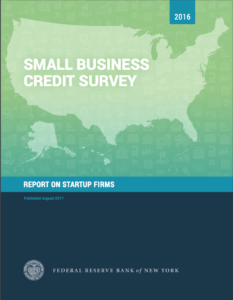 2016 Small Business Credit Survey: Report on Startup Firms
2016 Small Business Credit Survey: Report on Startup Firms
Federal Reserve Bank of New York
First published August 2017
This report is the second in a series of reports based on the 2016 Small Business Credit Survey (SBCS), a national collaboration of the Community Development Offices of the 12 Federal Reserve Banks. As a followup to the Report on Employer Firms issued in April 2017, the Report on Startup Firms provides an in-depth look at the financing and credit experiences of startups with employees—which we define as small businesses that were five years old or younger in 2016 and had full- or part-time employees.
Startups are of particular interest since they account for 34% of all small employer firms and play an outsized role in U.S. innovation and productivity. Young firms are the drivers of job growth in the United States, accounting for nearly all net new job creation and almost 20% of gross job creation. Yet, even as their importance has become more widely recognized, the rate of startup creation has been decreasing for years. And, of those ventures that launch, failure rates are high. Approximately one-third of new establishments fail within their first two years, and half fail within five years.
Given the importance of startups for the economy, the question of startup capital needs is of central importance. Access to capital is important for both firm formation and growth. While funding is the lifeblood of every company, capital is especially critical for startups. To reach scale, startups need to be able to secure expansion capital. The Report on Startup Firms offers detailed intelligence on startups’ financing needs and challenges, asking questions about capital requests, borrowing qualifications, applications, and success levels. The SBCS offers a unique dataset to examine the financing realities of firms that launched after the Great Recession, amid a challenging and changing financial landscape. Even though most small firms seek small amounts of financing (55% of 2016 SBCS respondents sought $100,000 or less), small-dollar credit is difficult to obtain. The small-dollar loan share of lending has fallen from 33% in 2008 to 22% in 2016 and continues to decline. Instead, firms may be turning to other financing sources. Product-wise, credit card lending has been rising since the recession, with implications for borrowing costs. In addition, a variety of online alternative lenders have introduced new lending products and services. The SBCS enables us to examine the interplay between these broader market trends and small business borrowers’ experiences.
Download Resource